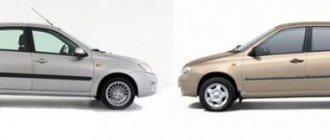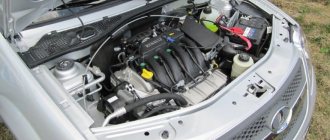Let us remind fans that the Lada Largus is a small-format universal “state car”, which was developed by AvtoVAZ with the direct participation of specialists from Renault-Nissan. This is reflected in the appearance of the car, since it is a derivative of the popular modification of the Dacia Logan MCV. The positive aspect of the universal “Russian” is its adaptability to domestic road conditions. This car can please you with its spacious interior, modern body design and spacious luggage compartment. It is these qualities that today form the basis for the priority of a car over the category of practical owners.
You should not ignore such a relevant indicator as gasoline consumption. In the Lada Largus station wagon, this parameter directly depends on the power plant option. Traditionally, driving style also makes a special contribution to the level of consumption.
The engines of this domestic car
For the power units that AvtoVAZ kindly equips its station wagons with, the developers used 4-cylinder blocks. The working volume of all “fiery hearts” is 1.6 liters.
The following motor versions exist:
- “K7M” is a unit with a 1.6 8-valve head design and is capable of producing 84 horsepower. The engine is produced at the Romanian branch of Automobile Dacia, owned by Renault.
- "K4M" - version 1.6 16 valves, produced at the European plant "Renault Espana". The unit's power rating reaches 105 hp. With. Also, an analogue of this motor is produced in the domestic division of OJSC AvtoVAZ. It is this option that ensures compliance with the EURO-5 regulations, although it has slightly lost its potential in performance (power – 102 hp, and torque – 145 N*m).
- The engine is from VAZ (code - “11189”), which has a traditional design with a 1.6 8-valve head and can generate a power of 87 hp. With.
Let us repeat that gasoline consumption directly depends on the engine version.
Various recommendations
You can often come across this question on various automotive forums, but no one can give a clear answer. Let's try to consider and come to a conclusion, what kind of gasoline is needed for this car?
Recommendations from the AvtoVAZ plant
Which of these will we choose for Largus?
According to the service book and manufacturer's recommendations, Largus must be filled with fuel with a medium or high octane number. So, the question arises, what kind of gasoline should be poured into the tank - AI-92, AI-95, AI-98, or the Premium and Euro varieties? In the same manual about the fuel system it is written that it is not lower than AI-95. This is due precisely to the effect on the fuel system, which better perceives this particular marking.
Renault engine manufacturer's recommendations
The factory recommendations are duplicated on the gas tank flap cover (only 95 and 98)
Since the Largus has a Renault engine, you should listen to this manufacturer when choosing gasoline.
An exact definition was found in the service book for the K4M and K7J engines. The fuel system must be filled with gasoline marked at least A-95E.
To reduce consumption, the manufacturer recommends using only 92 gasoline.
This fuel is designated AI-95 Euro on the domestic market.
Expert recommendations
In 2014, this car was tested on different types of fuel. Three cars with the same characteristics, into which AI-92, AI-95 and AI-98 were poured. Each of them was tested for different indicators.
When using AI-98, the engine overheated too much and the cooling fan could not cope. Therefore, experts noted that this brand of fuel is not very suitable for use in Lada cars.
When using AI-95, there was a noticeable increase in dynamics and a drop in consumption compared to AI-92. Thus, experts noted that the ideal option is to use this particular brand of fuel.
Motorists' experience
Experience says it's 95!
Based on the experience of motorists, we can say that AI-95 becomes the optimal option for use. After switching to this brand from AI-92, the dynamics noticeably increased, and the consumption decreased by almost 25%, which cannot but please the owners.
Also, auto mechanics note that when using AI-95, there is less deposits on the walls of the combustion chambers, and the fuel system becomes clogged and fails much less often. Therefore, it is recommended to fill Largus with this type of gasoline.
Economical driving
Let's consider the option with the K7M engine
LADA Largus with this version of the engine can boast a speed rating of 155 km per hour. Acceleration dynamics are not the strong point of this modification, because the first “hundred” is “exchanged” after 16.5 seconds. Fuel consumption regulated by the manufacturer is:
- for the urban cycle, the fuel consumption rate is at least 12.3 liters;
- on country roads the fuel consumption rate is about 7.2 liters;
- in mixed mode - approximately 7.5 liters.
New generation Lada
The presentation of Lada Largus, which is a joint project of VAZ and Renault, took place in 2011. The purpose of inventing this version of the Lada was to make the 2006 Dacia Logan similar to the Romanian car, suitable for Russian roads.
| Model | Consumption (highway) | Consumption (city) | Consumption (mixed cycle) |
| Lada Largus | 6.7 l/100 km | 10.6 l/100 km | 8.2 l/100 km |
Technical characteristics of the Lada Largus, fuel consumption and maximum speed for all models are almost the same
. The main configuration parameters include:
- Front-wheel drive;
- 1.6 liter engine;
- 5-speed manual transmission;
- The fuel used is gasoline;
Each car has an 8- and 16-valve engine, except for the Cross version. It is equipped only with a 16-valve engine. The maximum speed of the car is 156 km/h (with engine power of 84, 87 horsepower) and 165 km/h (engine with 102 and 105 horsepower). Acceleration to 100 kilometers is carried out in 14.5 and 13.5 seconds, respectively. The average fuel consumption of Largus per 100 km in the combined cycle is 8 liters.
Real fuel consumption on Largus
Practice shows that the indicated indicators of the Lada Largus can differ significantly, in most cases upward, especially on the 1.6 16-valve engine. This circumstance is influenced by factors such as:
- the mode in which the car was run in;
- driving style (aggressive style predictably increases consumption levels);
- the use of additional equipment by the owner of the Lada Largus, especially the climate system, which increases the load on the power plant (remember that the turned on air conditioner can increase the consumption rate to approximately 1 liter per 100 km of distance traveled);
- malfunctions directly in the power unit;
- use of low-quality fuel;
- operation in winter conditions, especially without the ability to sufficiently warm up the unit.
This video shows changes in fuel consumption of the Lada Largus in real driving conditions:
Also, the level of consumption can be affected by the flow of cars itself, because frequent jerks in traffic jams contribute to increased consumption.
Renault Duster timing belt replacement
Rear bumper Renault Duster
Compare Lifan x60 and Renault Duster
Forum: Lada Largus (station wagon)
- Hello. I bought a Lada Largus last year from Elex Polyus under a loan program. First impressions were very good. At the moment the car has covered 2,500 thousand, it seems to have become faster. pros: stable, more than 140 km.
h didn’t give it, it’s a pity that it’s still new, the handbrake is very gentle, the visibility in the mirrors is good, the interior of the cabin is 4. that seems to be all. cons: very stiff suspension, I don’t like that the revs don’t drop for a long time when you change from 1st to 2nd gear.
I’ll be honest, there are a lot of crickets in the panel, the noise is bad - you can hear even small pebbles hitting the threshold and it’s infuriating. Well, in general, a normal car, the Kander is excellent. music is top five. There are bugs in any car, I noticed with my friends.
so guys, choose better so as not to hold your head later. Lada Largus pulls a four. Good luck!!!
- I read the reviews and will add my own. We bought a Lada Largus in April 2013, a seven-seater in a luxury configuration. We have three children, so that's it. During this time there were no disappointments.
The question was how would it travel with seven passengers and cargo on such an engine? It drives great, seven of us went to the sea. + roof box 400 l. jam-packed, and no inconvenience. Immediately after the sea, we went to the Urals from Stavropol, again with seven of us. It was a super trip.
You don’t get tired on a long journey, there’s plenty of space, and the air conditioning copes with the heat even for the furthest passengers. The machine fulfilled its task with a bang, consumption in the combined cycle was 8.5 liters per 100 km, no problems arose, no bulbs burned out, no crickets yet.
As for beautiful and ugly, this car’s purpose is not to ride on the catwalk, but on our Russian roads, and it copes with this perfectly.
- I read a lot of reviews, wrote a few myself, and what I noticed was that there was less negativity about Largus, as if people were treating him kinder or something, and rightly so in my opinion. The car deserves both attention and respect.
With almost 40 years of continuous driving experience, I have changed a lot of cars, both ours and foreign cars, and believe me, the Casket is a good car. I bought it (luxury 7 seats platinum) two months ago, I really like the car in everything, especially: visibility, roominess, handling and warmth.
At -20 you can drive in jackets and without shoes, all the windows are clean. Nothing in the car bothers me, neither where anything is turned on and adjusted, nor what is screwed on where, and the shelf in the cabin and the radio with Bluetooth paired with the phone are super. We will talk about gasoline consumption after a full break-in, but for now after 1700 km.
9.4 in the city 8.8 on the highway. We'll wait until summer to find out how the air conditioner works. I only drive on 95 gasoline and only Lukoil. All the best and happy shopping.
- Take Largus without hesitation. There are no perfect cars.
- The author sold this wonderful thing after six months of ownership. Cheating Vase in everything from creation to service.
The first thing that captivates you in purchasing a Lada Largus is 7 seats, no matter how wrong it is in the second row, seat three people there and you will hear a lot of unflattering words, the belt buckles will fit right into the butt and that’s not all, the middle one needs to be fastened and the belt should be pulled from the roof of the butt, oh made me laugh, so forget about the three two.
The third row is fine, but where are the nine things? The car is a country house, but with the third row there is no space in the trunk, another minus and we get the usual five. Okay, we sorted it out, we drove up to 90 km/h, still nothing, but we get on the highway and oh my God, the engine at 110 screams like crazy in fifth gear, at 3,500 rpm, the transmission howls in general hell.
ok, they removed it, and at the beginning it was still a delivery van, with an appropriate transmission, but did anyone take fuel consumption into account? 9 liters on the highway and 15 in the city. Yes, Gazelle eats less.
About the quality of workmanship, a crack in the metal on the threshold, eating rubber from the rear during a cold start, the revolutions fluctuate, the boot has come off the spring, and the notorious VAZ service is all over you. Apart from irritation and hatred towards VAZ, the author does not seem to cause this, and the West realized this and quickly curtailed the production of this car, and before there were also queues. Now the Hyundai Grand Starex is the family author of 08, the mileage was 45 thousand, now it’s already 60, the diesel fuel consumption is the same but fits 8 people comfortably. If you have a large family, then your choice is a minibus and not this, it’s not clear what.
Source: https://auto.ironhorse.ru/lada-largus-mcv_1917.html/comment-page-24?comments=1
Fuel consumption on the highway
To achieve a certain savings, you must adhere to the speed limit indicated by state regulations. The formation of actual fuel consumption occurs under various driving modes, during which the speed can increase from 30 km per hour to a significant 130 km per hour. The average speed for LADA Largus is approximately 77 km per hour.
Important! Based on the analysis, based on numerous reviews of Largus owners, a conclusion can be made regarding average fuel consumption. So, for this particular station wagon it is about 7.2 liters.
What factors influence the increase in gasoline costs?
The efficiency of cars of the Lada Largus family is influenced by:
- technical condition of the chassis and transmission;
- weight of cargo or number of passengers in the cabin;
- road profile and congestion;
- management style;
- condition of gasoline injection nozzles and catalytic converter;
- average speed;
- air temperature and road surface condition;
- frequency of air conditioner use.
The efficiency of cars is influenced by the technical condition and driving style.
Efficiency is affected by the degree of grinding in of engine and transmission parts. The plant allows increased fuel consumption during the first 10-12 thousand km; after scheduled maintenance, consumption stabilizes.
Real fuel consumption of Largus in urban conditions
If the driver has set himself the goal of determining the real level of fuel consumption of his LADA Largus station wagon, then for the purity of the experiment he will need to resort to the following measures:
- deliberately getting into traffic;
- be in rush hour traffic;
- stand idle at traffic lights or find a street with the maximum number of such control devices;
- Do not forget about the need for a constantly running air conditioner.
Such driving conditions, according to accumulated statistics, can lead to a real level of urban consumption equal to about 13.3 liters per “hundred” of mileage.
Reviews from car owners
As you know, often passport data does not quite correspond to those that car owners subsequently record during operation. The reasons for this are known to everyone, and it is hardly worth talking about it again and again. However, it is possible, and even necessary, to analyze the reviews of real Lada Largus owners.
Most car owners note a slight excess of fuel consumption over the passport data. So, judging by their reviews on car owner forums on the Internet, for engines with a capacity of 84 horsepower, the actual gasoline consumption when driving around the city is 12.5 liters per 100 kilometers in the city, and when traveling on the highway - 8 liters. On average, the volume of consumption in mixed mode will be about 9.5 liters per 100 kilometers.
The 87-horsepower engines have almost the same performance in both modes; on average, they consume up to 10 liters of fuel per 100 kilometers.
The 105-horsepower engines of the Lada Largus in mixed mode consume 9-10 liters of gasoline per 100 kilometers, when driving around the city - up to 13 liters, and on the highway, judging by the reviews of the owners, the figure ranges from 7 to 9 liters.











